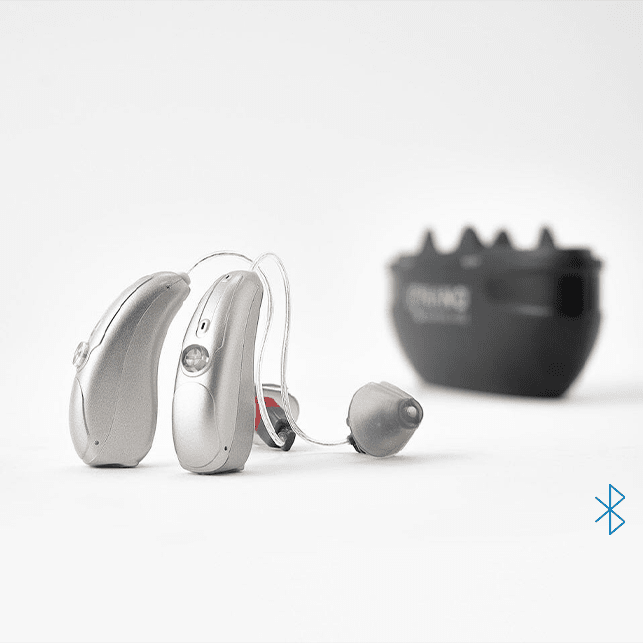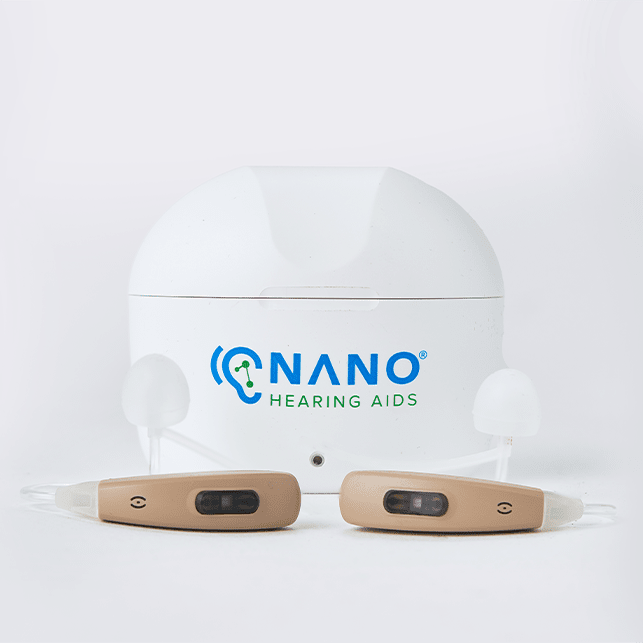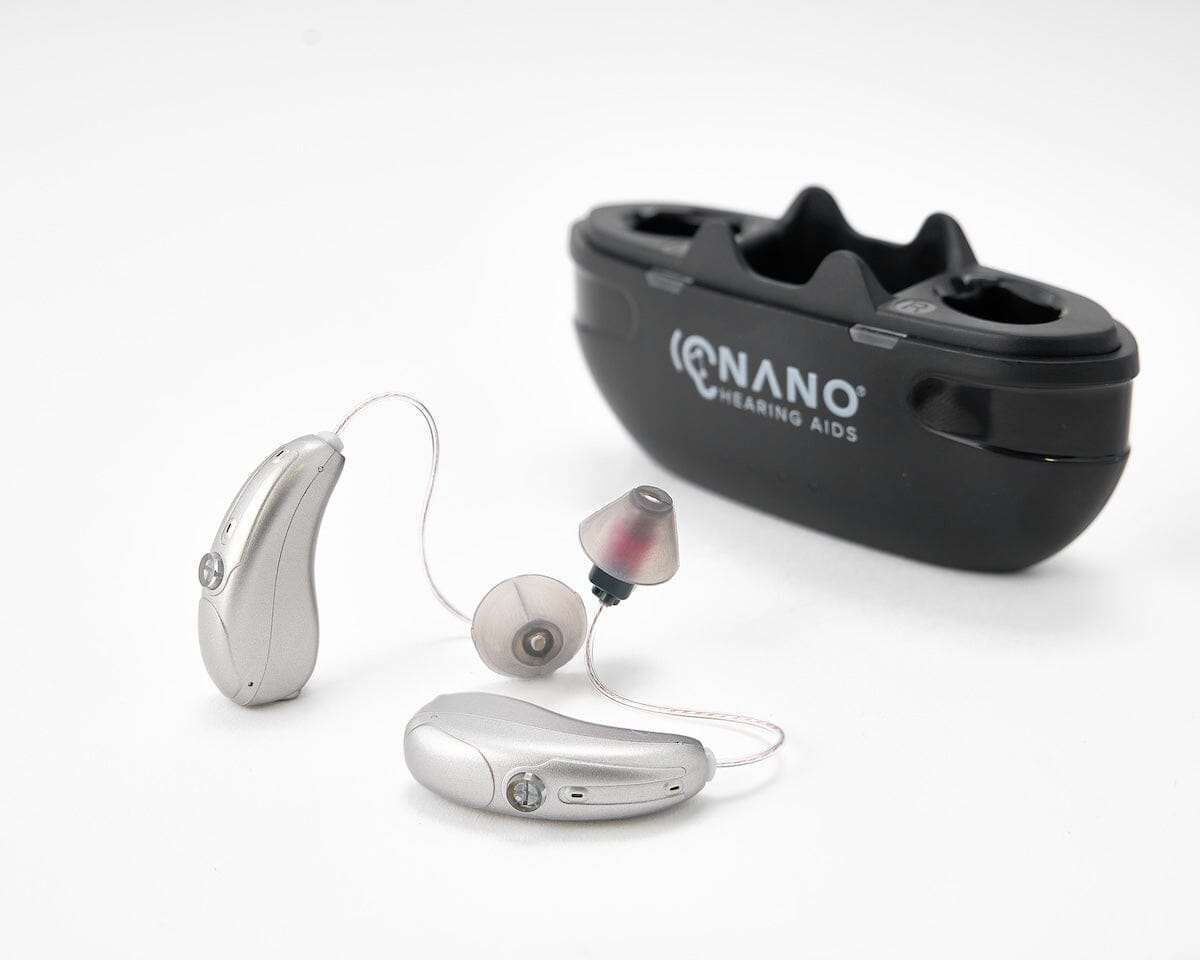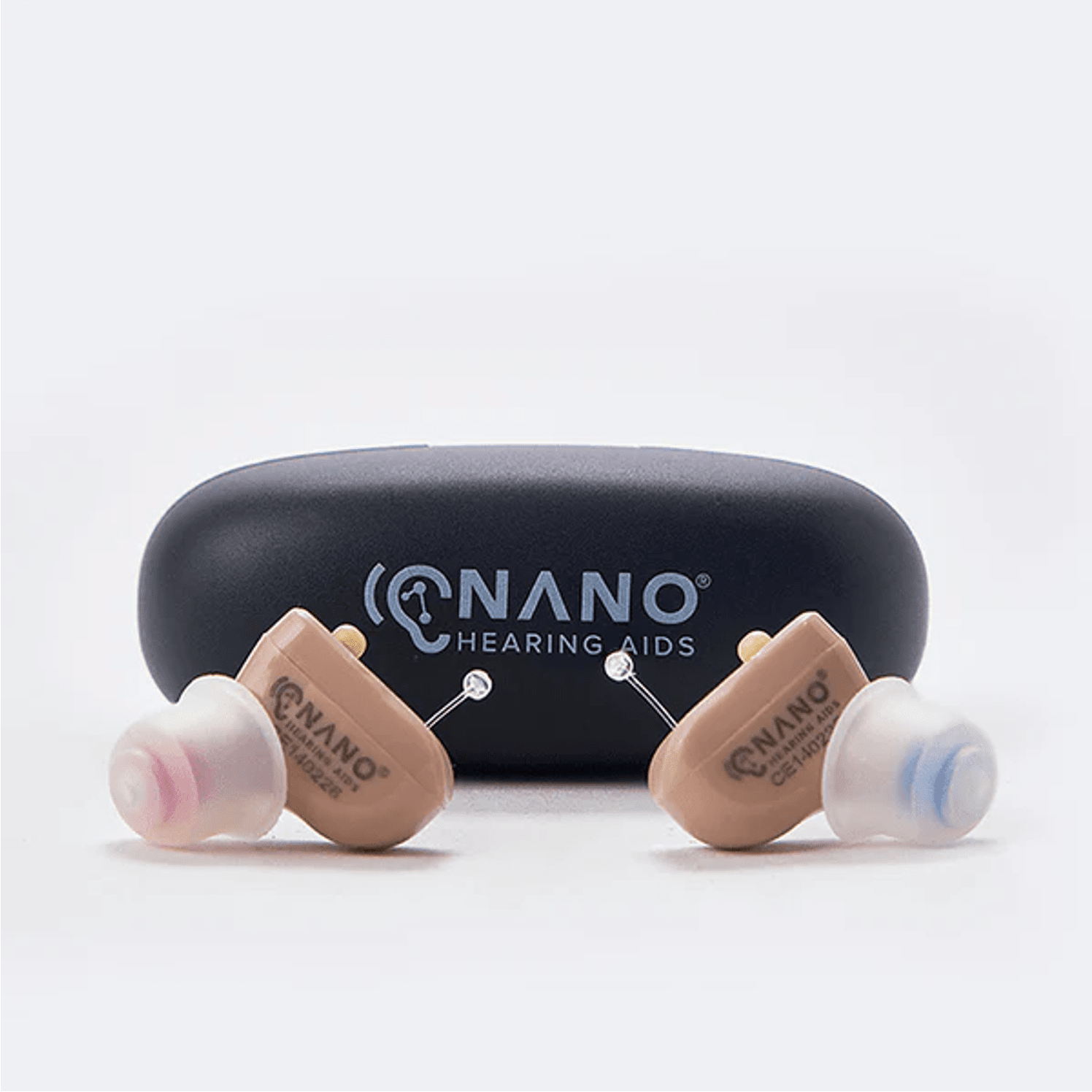Key Takeaways
- RIC (Receiver-In-Canal) hearing aids consist of four main parts: the hearing aid body, receiver (speaker), dome or earmold, and batteries.
- The hearing aid body houses the computer processor and microphones, which are essential for sound processing.
- The receiver, or speaker, is responsible for delivering the amplified sound directly into the ear canal.
- Domes or earmolds deliver a comfortable fit and clear sound, and they come in various styles to suit different ear shapes and hearing needs.
- Nano's Audacity RIC OTC hearing aid offers features like app control, Bluetooth connectivity, a portable charging case, multi-function button, feedback cancellation, and noise management - all for a versatile and high-performance hearing aid.
NANO Hearing Aids are FDA-registered, Class I devices. Our OTC hearing aids are designed for individuals over 18 years of age with perceived mild to moderate hearing impairment. With prices starting at just $297, they offer a viable solution for those looking to improve their hearing without breaking the bank.
Why RIC Hearing Aids Are Popular
RIC hearing aids strike the right balance between comfort, aesthetics, and advanced features. The receiver sits inside the ear canal while the main body rests behind the ear, making these devices less noticeable and more comfortable for extended wear.
Main Components of RIC Hearing Aids
Hearing Aid Body
The body houses the device's "brain" - the computer processor and microphones - capturing, processing, and sending sound to the receiver. It typically sits behind the ear, making it less visible and more secure. This part includes buttons or controls for adjusting volume and settings, with some models featuring wireless connectivity for streaming audio from devices like smartphones or TVs.
Receiver (Speaker)
The receiver delivers amplified sound directly into your ear canal, and is connected to the hearing aid body by a thin wire for a discreet appearance and better sound quality. Regular maintenance keeps it clean and free from earwax buildup.
Dome or Earmold
The dome or earmold fits inside your ear canal, securing the receiver and ensuring effective sound delivery.
Domes, typically made of soft silicone, come in various sizes and styles.
Earmolds are custom-made for the exact shape of your ear canal, and are recommended for those with more severe hearing loss or who need a more secure fit.
How Each Component Functions
Sound Delivery Through Domes
- Open Domes: Allow natural sounds in while amplifying specific frequencies—ideal for perceived mild to moderate hearing loss.
- Closed Domes: Block more of the external noise, providing more amplification—suitable for perceived moderate to severe hearing loss.
- Power Domes: Offer maximum amplification for significant hearing impairments.
Earmolds
Custom-made to fit your ear canal, offering a secure fit, they are particularly recommended for perceived moderate to severe hearing loss. Proper fit is crucial for effective sound delivery, as a poor fit can lead to feedback, discomfort, and reduced sound quality.
Battery Life and Maintenance
RIC hearing aids typically use rechargeable batteries, which provide a full day of use after an overnight charge, offering convenience and eliminating the need for frequent replacements. Proper maintenance is essential—ensure your hearing aids are fully charged to avoid interruptions in functionality.
Alternatively, some RIC hearing aids may use disposable batteries, which generally require replacement every 5-7 days. For optimal performance, follow the manufacturer’s instructions for battery care, charging, and storage.
Advantages of RIC Hearing Aids
Nano Audacity RIC - Sleek design for a comfortable and discreet fit.

RIC hearing aids offer numerous benefits that make them a popular choice among users with varying degrees of hearing loss. These advantages range from comfort and aesthetics to advanced technological features.
Advantages of RIC Hearing Aids

Caring for RIC Hearing Aids
Keeping the Microphones Clean
Use a soft, dry cloth to wipe the exterior of the hearing aid body regularly. Avoid water or cleaning solutions—they can damage delicate components.
If you notice dirt or debris around the microphones, use a small brush or a specialized hearing aid cleaning tool to remove it.
Proper Maintenance of the Receiver Wire
Inspect the receiver wire regularly for signs of wear or damage—replace it if necessary.
Handle the receiver wire with care when inserting or removing the hearing aid—avoid pulling or twisting the wire.
Cleaning Domes and Earmolds
Remove the dome or earmold from the receiver—use a soft, damp cloth to wipe away earwax or debris. Allow them to dry completely before reattaching.
For thorough cleaning, use a specialized hearing aid cleaning tool or a gentle brush to remove buildup from the small openings.
How Nano Hearing Aids Can Help
Nano Audacity RIC - rechargeable hearing aids with customizable ear-tips and feedback cancellation.
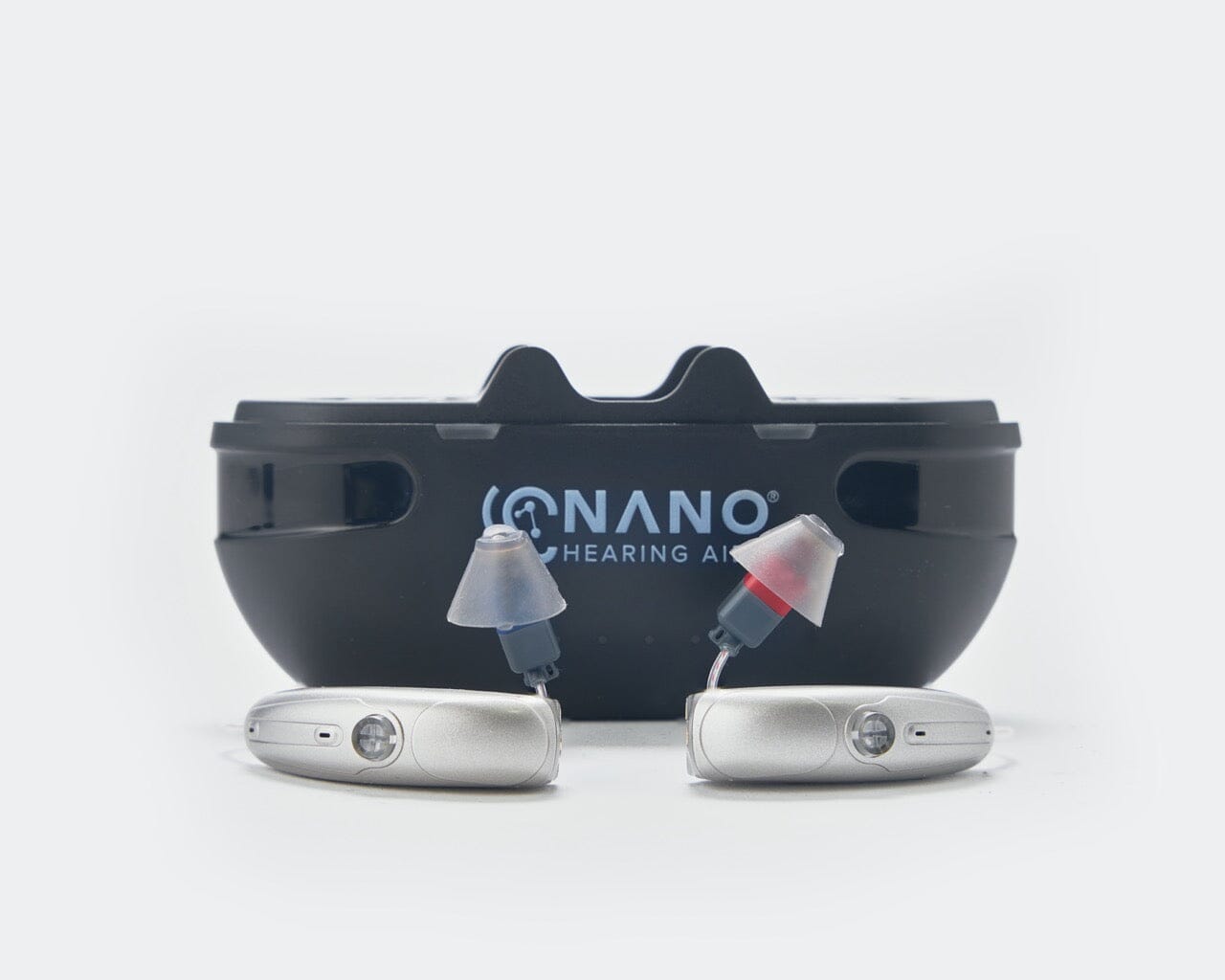
At Nano, our RIC hearing aids provide the best sound quality and comfort.
For over 7 years, our FDA-registered, Class I medical devices have ensured safety and effectiveness. Our latest model, the Nano Audacity RIC, exemplifies our commitment to quality and innovation.
With a price of $697, it offers full control through the Nano Audacity App and Bluetooth readiness for calls and audio streaming.
The Audacity RIC provides crystal clear, authentic sound through powerful feedback cancellation and noise management - directional microphone technology enhances sound quality for clearer conversations. It comes with different sizes and types of domes for maximum comfort, ensuring a comfortable, secure fit.
Our hearing aids are available over-the-counter, making them accessible without a prescription. By choosing Nano, you get a reliable, effective hearing solution that meets your needs.
Frequently Asked Questions
What makes RIC hearing aids different from other types?
RIC hearing aids differ from other types primarily in their design and functionality. The receiver sits inside the ear canal while the main body rests behind the ear, allowing for better sound quality and a more discreet appearance.
RIC hearing aids often incorporate the latest technological advancements, such as Bluetooth connectivity and noise reduction, making them a popular choice for many users.
How long do RIC hearing aid batteries last?
Disposable batteries for RIC hearing aids typically last 5 to 7 days, depending on usage and the specific model.
Nano’s RIC hearing aids feature rechargeable batteries, making them a convenient option. Rechargeable batteries provide a full day of use after an overnight charge, eliminating the need for frequent battery replacements. Simply ensure the hearing aids are charged properly to avoid any interruptions in functionality.
Can RIC hearing aids be used for severe hearing loss?
Nano’s RIC hearing aids are designed specifically for individuals with perceived mild to moderate hearing loss. While they offer powerful sound amplification and advanced features, they may not be suitable for those with severe hearing loss.
It’s always recommended to consult with a hearing care professional to determine the best solution for your specific needs.
How often should I clean my RIC hearing aid parts?
Clean the domes or earmolds and the receiver wire at least once a week. Wipe down the hearing aid body and microphones regularly with a soft, dry cloth to remove dirt or debris.
Follow the manufacturer's instructions for cleaning and maintenance to ensure optimal performance.
Why Should I Choose Nano RIC Hearing Aids?
Nano RIC Hearing Aids are designed with advanced features—providing superior sound quality and comfort.
Our RIC hearing aids are FDA-registered, Class I medical devices, ensuring safety and effectiveness. They offer Bluetooth connectivity, noise reduction, and customizable settings to suit your specific needs.
At Nano, we are committed to offering high-quality, reliable hearing solutions to meet your needs. If you have further questions or need assistance, please don't hesitate to reach out to us.

